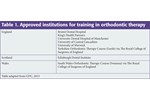
Making a difference
How Teeth Team is changing children's oral health statistics in a deprived area of the UK – a programme that ‘wouldn't be as successful if it wasn't for its dental nurses’

How Teeth Team is changing children's oral health statistics in a deprived area of the UK – a programme that ‘wouldn't be as successful if it wasn't for its dental nurses’

If you're working as a dental nurse and considering a career in periodontology, you could choose to add a new set of skills to your existing toolkit or you could focus 100% on gums. So, do you keep your options open or channel everything into one area?

The Nottingham Oral Health Team – aka the Tooth Fairies – was created in 2000 by the Salaried Dental Service and consisted of just one tooth fairy – Julia Wilkinson. Since then, the team moved to work within public health and one became three with Justine Halls and Rebecca Soong-Towell making up the

Want to help your patients back to better dental health? Ben Underwood's Brush DJ app and videos have been a huge success. We talk to him about his innovation and how dental nurses are in a perfect position to make a difference

Your ability to raise the bar illustrates dedication to professional development and a desire for a long career in dentistry – and we're here to help you achieve both

According to research, you have just seven seconds to make a lasting first impression; thankfully, they weren't referring to dental impressions! Dentist and tutor Nyree Whitley looks at an extended duty…

Graham Cope enlightens us on the controversial pull of e-cigarettes and their role in smoking cessation

Just what are the differences between men and women who present in the dental chair – and what do they mean for you? Peter Baker investigates

Steve Williams discusses the role dental teams have in battling oral cancer.

What sort of additional roles can you take on within a practice – and where will they take you?

Your role as a dental nurse has never been so important in the delivery of dentistry. Here, Dental Nursing catches up with Sara Hurley, Chief Dental Officer for England, to hear why she believes it's all about ‘communication, communication, communication’

A look at the vital roles of dental nurses by Claire Warner and Martyn Waddington

Janine Brooks looks at the opportunities – and explains why you should grab any that may come your way!

Mouths reveal a lot about our overall wellbeing, so the dental team is perfectly placed to act as gatekeepers to many pathways to better health

Orthodontic therapists are a class of dental care professionals and play an important role within the dental team. This article explains the roles and responsibilities and the training pathway to become an orthodontic therapist